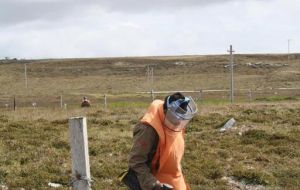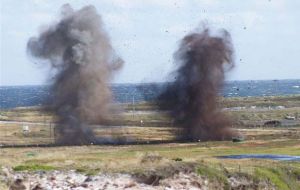MercoPress. South Atlantic News Agency
Falkland Islands de-mining pilot project and the challenge of full clearance
 De-mining expert working in Falklands’ peaty soil in search of minimum metal mines
De-mining expert working in Falklands’ peaty soil in search of minimum metal mines As a signatory to the Ottawa Convention, the United Kingdom is required under International Humanitarian Law to remove and destroy all anti-personnel landmines on its sovereign territory. About 20,000 landmines remain within clearly fenced and marked off areas on the Falkland Islands as a result of the 1982 conflict; while not all of these are anti-personnel mines, the United Kingdom is obliged to clear all the mined areas across both East and West Falklands under the Ottawa Convention.
There have not been any civilian injuries associated with landmines or Unexploded Explosive Ordnance (UXO) since the conflict partly because of careful management of suspect areas but also because of a good mine education process in schools and the media. The mined areas cover a very small percentage of the whole Falklands’ land area (about 0.1%) and therefore overall they do not represent a significant humanitarian, social or economic threat to the islanders.
Following the results of the successful Joint UK-Argentine Feasibility Study which were finalised in 2007, the UK Government in close consultation with the Falkland Islands Government decided to start a pilot clearance project of four suspect areas; two near Stanley, one in Goose Green and one in Fox Bay East. These were chosen because they represented four very different types of terrain and mine/UXO threat. In addition the mined area at Surf Bay was selected because it was a well used area before the 1982 conflict and it contained about 1000 landmines, according to the minefield records; this represents some 5% of the overall remaining landmine threat. The National Mine Action Authority was formally set up in the United Kingdom during 2009.
The Falkland Island Demining Programme Office (FIDPO) was established in Stanley in early October 2009. It is designed to oversee the Project and provide the essential external Quality Assurance and Quality Control of the demining process. As a result of a detailed evaluation process, a Demining Contractor was selected for the pilot clearance project by the UK Foreign and Commonwealth Office (FCO). Following a period of the in-country training of their experienced de-miners that focused on the country specific challenges of terrain, weather and mine type, the Demining Contractor was granted partial accreditation by the FIDPO to start demining in Surf Bay and on Sapper Hill in early December 2009. The FIDPO and de-mining contractor are necessarily separate contracts to ensure there is no conflict of interest and quality control is not compromised.
The Surf Bay minefield (SA-008) contains anti-vehicle (SB81) and anti-personnel (SB33) landmines both of which have a small amount of detectable metal within them. These were manufactured in Italy and provided with a 20 year guarantee. So far, [458] out of the 1000 or so landmines have been located and destroyed and all appear to be in good working condition even after 27 years in the ground. The mines are blown up where they are found on a periodic basis. Most of the mines have been laid in panels of two or more rows of mines and most of these panels have already been located. The plan is to follow each of the mine rows using a manual layered excavation technique to reach down to 20 cm (the depth set by the contract) in order to extract all the landmines before clearing and checking the remainder of the area. Detection of these specific Italian landmines varies between 12 – 15 cm beneath the surface in both peat and sand using a metal detector.
The Sapper Hill minefield (SA-011) contains almost 200 anti-personnel mines (P4B) which have a very low metal content. These were manufactured in Spain and have proved the most difficult to detect because their only metal content is the 0.14 gram of steel in the spring. There is some lead foil in many of these mines but as not all of them still have this remaining, detection of this foil only is not an option. Adopting a manual full excavation technique (essentially digging up the ground) to reach the contract depth and following the mine rows has exposed [146] P4Bs to date and all appear to be in very good condition, both those in the peat and those on the surfaces that have been exposed to the weather. In addition to clearing the minefield itself, a search is being conducted between the Stanley-Darwin Road and the minefield to establish whether any unexploded devices remain under the surface as it was the site of a cluster munitions strike during the 1982 conflict. So far unexploded BL 755 cluster bomb devices have been located sub-surface and destroyed.
The landmine and UXO threat at both Goose Green and Fox Bay are less well defined and until technical surveys are conducted on those sites at the latter end of February 2010, it is not possible to comment on what will be required to clear those sites.
Concerns about the environmental impact of the project were raised before it began. The Planning Permission required that an acceptable ground remediation plan was submitted with the De-mining Clearance Plan and that steps were taken to educate the de-miners in the identification of rare plant species expected in the area. The Clearance Plans envisage dividing the cleared areas into three parts; one part being left to recover naturally; one part having the cut vegetation replaced so that seeds from the cuttings drop and germinate; and a further area is to be left for a different approach to be specified and agreed by the Environmental Planning Department. These additional planning requirements are not always associated with Mine Action programmes.
The project aims to be complete by the end of this austral summer. As a result of a very poor summer weather so far and the difficulty of detecting the minimum metal mines, further demining reinforcements (15) are being flown in to assist in reaching the project objectives. They are likely to be deployed to Goose Green and Fox Bay in late February after a period of in-country training.
Once this pilot phase is complete, the UK Government will have a much better understanding about the challenges of the remaining suspect areas. This phase of the clearance will inform future projects, not only about the technical and environmental challenges associated with clearance in the Falkland Islands but also about the logistic and support challenges of operating within a limited infrastructure some distance from the UK. For information e-mail info@fidpo.org
By Robin Swanson, Demining Programme Manager - Stanley





Top Comments
Disclaimer & comment rules-

-

-

Read all commentsAre the contractors using dogs? Do they have satellital help? Have they considered placing ads on the main two Argentine newspapers that are read in all the country viz. 'La Nacion' & 'Clarin' asking for any data that could lead to non-charted minefields or even mines planted at random? Have they asked islanders who might have possible made acquaintances of Argentine officers or other troops, either during the war of after it, for their emails, phone numbers or postal addresses?
Feb 08th, 2010 - 03:48 pm 0No argie, it is easier: putting a kelper in each mine we could find the solution of the self determination contradiction.
Feb 14th, 2010 - 04:51 am 0what ever.
Feb 14th, 2010 - 04:18 pm 0Commenting for this story is now closed.
If you have a Facebook account, become a fan and comment on our Facebook Page!